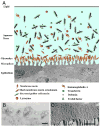Membrane-tethered mucins have multiple functions on the ocular surface
- PMID: 20223235
- PMCID: PMC2893012
- DOI: 10.1016/j.exer.2010.02.014
Membrane-tethered mucins have multiple functions on the ocular surface
Abstract
Membrane-tethered mucins are large glycoproteins present in the glycocalyx along the apical surface of all wet-surfaced epithelia of the body, including that of the ocular surface. Originally thought to function only in epithelial surface lubrication and hydration, data now indicate that the mucins are multifunctional molecules, each having unique as well as common functions. This review summarizes current knowledge regarding the three major membrane mucins of the ocular surface, MUC1, MUC4, and MUC16. The mucins vary in their ocular surface distribution, size, structural motifs, and functions. The ectodomains of each are released into the tear film and are, thus, a component of the soluble mucins of the tear film. Both animal and in vitro models for their study are herein described, as are alterations of the mucins in ocular surface disease.
Copyright 2010 Elsevier Ltd. All rights reserved.
Figures



References
-
- Araki-Sasaki K, Ohashi Y, Sasabe T, Hayashi K, Watanabe H, Tano Y, Handa H. An SV40-immortalized human corneal epithelial cell line and its characterization. Invest Ophthalmol Vis Sci. 1995;36:614–621. - PubMed
-
- Arango ME, Li P, Komatsu M, Montes C, Carraway CA, Carraway KL. Production and localization of Muc4/sialomucin complex and its receptor tyrosine kinase ErbB2 in the rat lacrimal gland. Invest Ophthalmol Vis Sci. 2001;42:2749–2756. - PubMed
-
- Argueso P, Balaram M, Spurr-Michaud S, Keutmann HT, Dana MR, Gipson IK. Decreased levels of the goblet cell mucin MUC5AC in tears of patients with Sjogren syndrome. Invest Ophthalmol Vis Sci. 2002;43:1004–1011. - PubMed
Publication types
MeSH terms
Substances
Grants and funding
LinkOut - more resources
Full Text Sources
Other Literature Sources
Research Materials
Miscellaneous

